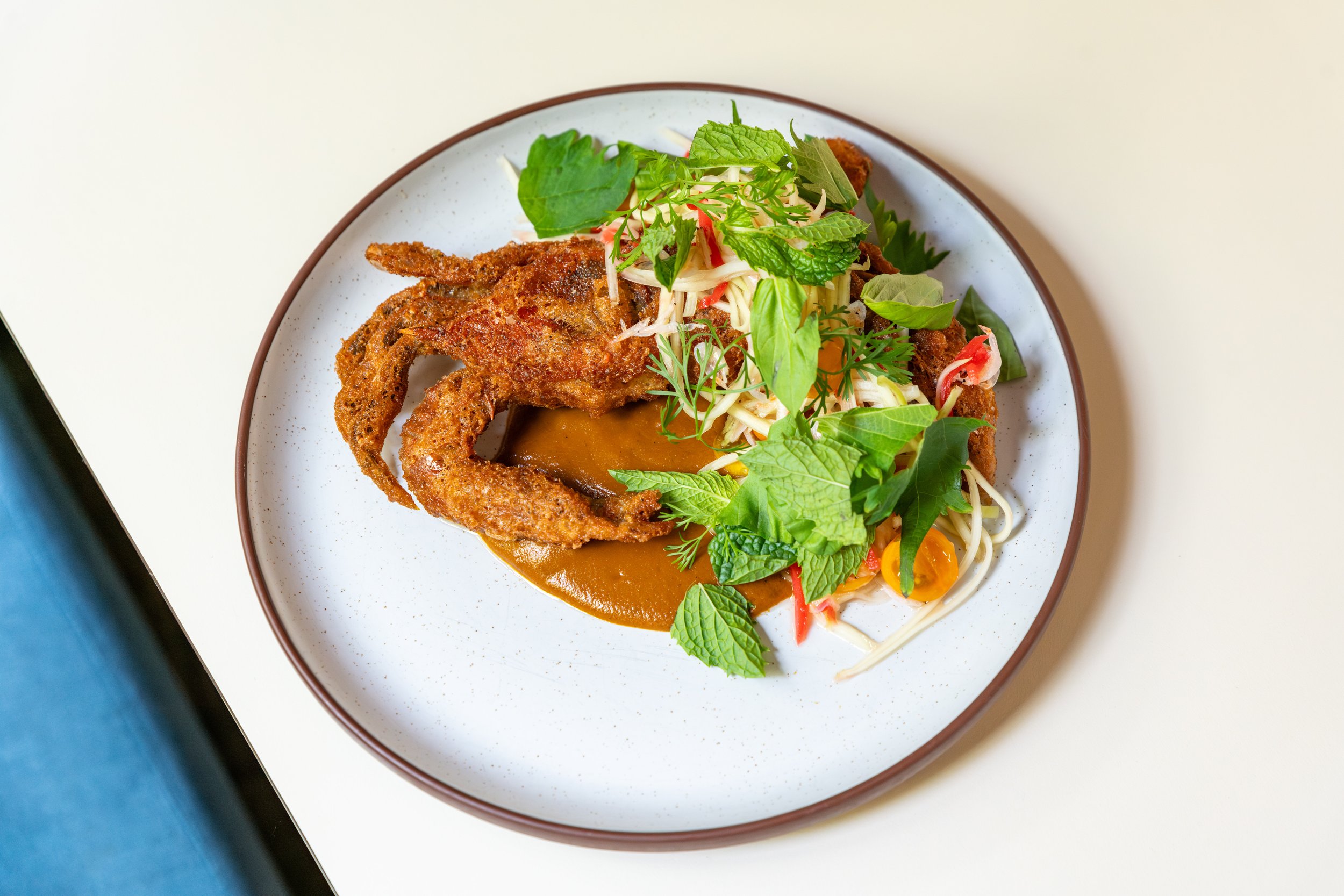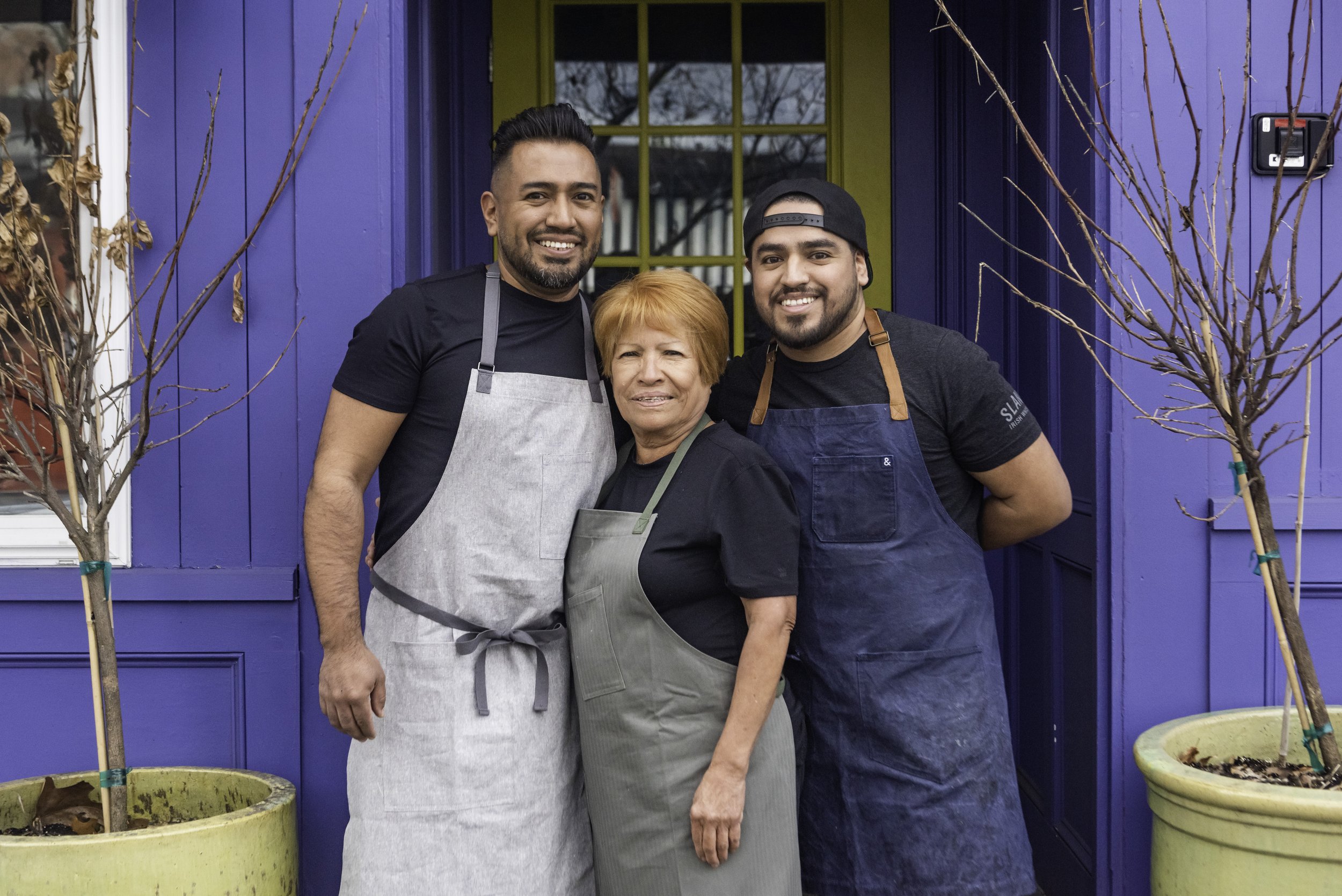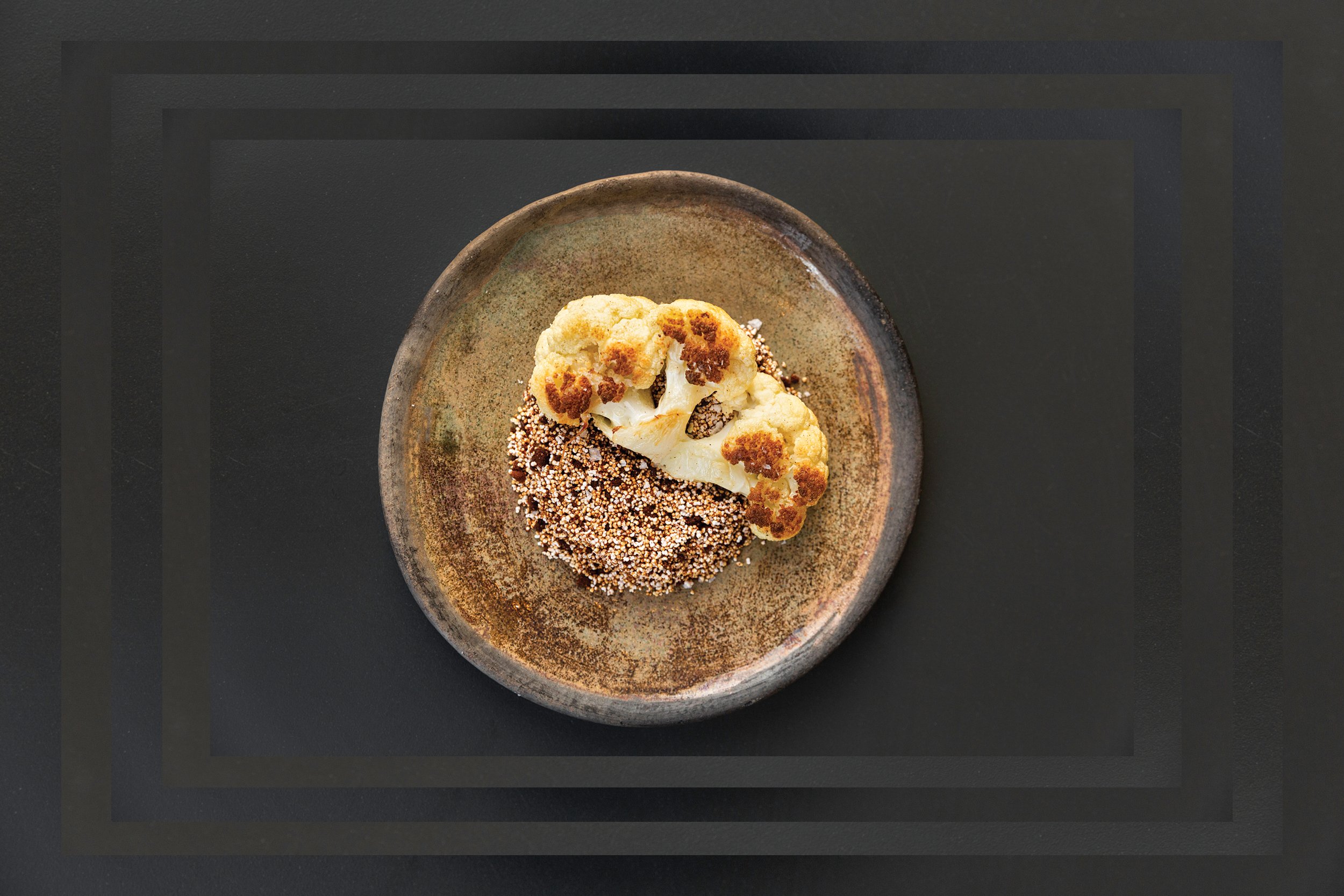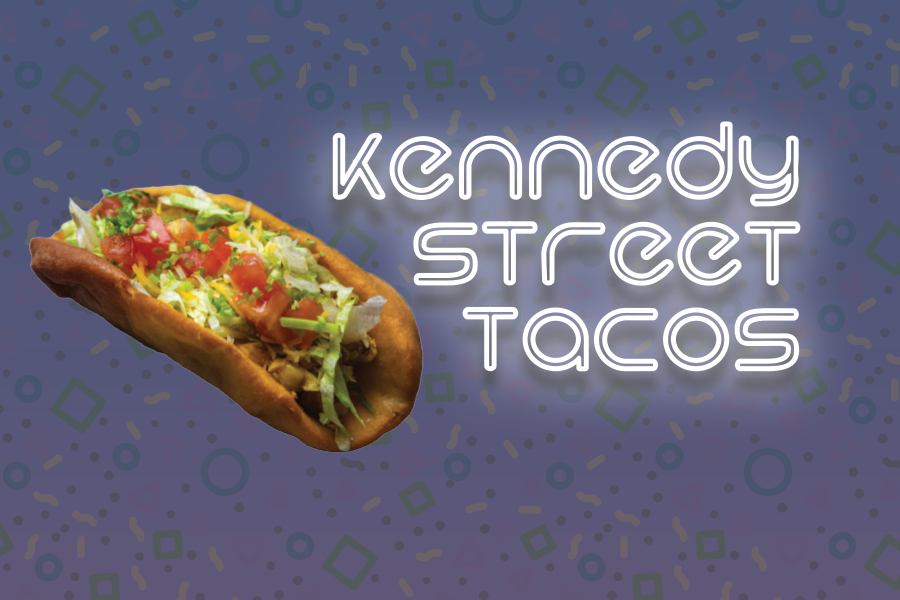Mexican Cuisine in the Heartland
Tacos, tortas, conchas, and elote are Chicago cuisine.
Crispy Octopus Taco, Pineapple Vinegar, Squid Ink Tortilla, Avocado, and Cebollitas at Birreria Zaragoza
On his way to school through Chicago’s Little Village, young Alexander Roman would stop by El Nopal on 26th Street for conchas, a Mexican sweet pastry with a dyed sugar coating on top. “People see it and think it’s a dry pastry that no one likes. If done well, it’s moist and soft and pillowy—it’s an experience,” says Roman, Rising Star Baker at Somerset. The neighborhoods of Little Village and Pilsen are home to the largest Mexican-American community in Chicago, part of more than 2 million people in the metro area.
Mexican immigrants arrived in Chicago at the turn of the century to work at steel mills and slaughterhouses and settled in working-class neighborhoods among Eastern Europeans on Chicago’s South Side. There, a contingent of restaurants began to take hold, serving traditional food and a sense of home to those who couldn’t return to theirs. “The groundwork was laid by Mexican immigrants in the 1940s, 50s, and 60s—we were able to cook our own food and off er it to the public,” says Rising Star Chef Jonathan Zaragoza, whose family owns Birreria Zaragoza in Archer Heights.
Roman and Zaragoza are part of a younger generation of Mexican-American chefs in Chicago who are cooking their heritage. “[These chefs] are coming up through the chef community and culinary schools, rather than forging ahead without professional guidance. That’s a major shift,” says Rick Bayless, who arguably primed white Chicago’s mild Midwestern palates with his cooking at Frontera Grill and Topolobampo. Bayless has dedicated his career to researching Mexican traditions and bringing the country’s ingredients, dishes, and stories back to Chicago.
Chef Jonathan zaragoza of Birreria Zaragoza
Roasted Beets, Mole Amarillo, Marcona Almonds, Chapuline Vinaigrette, Fennel, Fermented Radish, and Goat’s Milk Feta At Birreria Zaragoza
Thirteen years after Bayless opened Frontera Grill, and after a year cooking at Everest in Chicago, Enrique Olvera opened Pujol in Mexico City, and his work inspired a whole new generation of young Mexican cooks. “He went full-on fine dining and broke the delusion that Mexican food is just tacos and tortas,” says Roman. Olvera established Mexican cuisine as world class—as complex and codified as French and the other classical cuisines. “A lot of young cooks started going to Spain, instead of France or Germany and thought, ‘I can do this kind of stuff when I get back home.’ Then they started seeing how rich of an environment there was [in Mexico]. Eight to 10 years ago, people started paying attention,” says Diana Dávila, chef-owner of Mi Tocaya Antojeria in Logan Square.
Birrieria Zaragoza serves a 100-year old recipe for spicy braised goat. But in his collaboration dinners and pop-ups, Zaragoza straddles the line between traditional and modern. He trained with Frank Brunacci at Sixteen and Andrew Zimmerman at Sepia, and he flexes those skills with dishes like roasted beets, mole amarillo, marcona almonds, chapuline vinaigrette, fennel, fermented radish, and goats milk feta. “I love what I do, but if I can’t showcase the other side of my cooking, we can’t push forward, and that’s the goal,” says Zaragoza.
Dávila grew up working at her parent’s upscale Mexican restaurant, Hacienda Jalapeños, and cut her teeth at Boka during Giuseppe Tentori’s tenure. “[At Mi Tocaya] it’s like a Mexican mother is cooking the food. Here I get to combine being a woman, a mother, and a professional cook,” says Dávila, whose cuisine references regional Mexican dishes while incorporating local ingredients. Dávila learned to make mole amarillo in Oaxaca and pairs it with cold water arctic char, Brussels sprouts, endive, and eggplant. Hailing from Puebla, chiles en nogado—a dish of stuffed poblanos with walnut sauce and pomegranate— gets a Chicago-style makeover in the form of pork albondigas en nogado, pecan-Sherry sauce, charred shishitos, and candied cranberries.
Pork Albondigas en Nogada, Pecan-Sherry Sauce, Charred Shishitos, and Candied Cranberries
Chef Diana Davila of Mi Tocaya Antojería
Dávila is cooking from the uppermost region of Mexico—the Midwest. So is Rick Ortiz, who owns three locations of Antique Taco with his wife Ashley. His potato-poblano tacos with potato skins and cheddar are gloriously Midwestern (recipe here), as are fried Wisconsin cheese curds chummed up with house chorizo, jalapeños, and crema.
Non-Mexican (aka white) chefs are also contributing to the evolution. One of Bayless’ most important contributions is the cooks who come up through his brigade-style kitchens learning how to make salsas and moles rather than French mother sauces. “As a proud Mexican, if somebody can bring my food, my culture to the forefront, if they can do that for Mexican food in Chicago, that’s a win,” says Zaragoza.
Brian Enyart traveled and cooked with Bayless for 14 years and knows the intricacies of authentic regional Mexican cuisine. He studied, ate, and replicated it. When it came time to open Dos Urban Cantina with wife and partner Jennifer Jones (who also worked for Bayless), he felt less bound by authenticity and more inspired to cook from his Midwestern heart and hands. A bellyfilling bowl of aligot potatoes, charred broccoli, spring spinach, salsa macha, and green chorizo is Enyart’s riff on queso fundido, and it’s so comforting and compelling that you want to bury your head it in and cry.
Dan Salls is another Bayless alum who has devoted his career to Mexican cuisine. He spent nearly a year in Mexico before opening Quiote in Logan Square. “When we opened, we were nervous,” says Salls. “I’m not Mexican. I’m a Jew from the suburbs of Chicago. We didn’t want to cook the same stuff, and certainly didn’t want fake Mexican food for the masses. We just went out doing food that felt personal to us.” For Salls, that means a tostada presented in reverse, with a crispy tortilla covering a bowl of warm crab, hot sauce aïoli, and mango vinegar-pickled mustard seeds. It’s a visual reference to a plating style born in Chicago fine-dining with updated flavors of Baja.
Coming from a Midwestern farm family, Rising Star Chef Julie Warpinski joined the opening team of Bayless’ fast casual Xoco right out of culinary school. “It was my first foray into high-volume Mexican, and it was eye-opening. I never thought I would be into the cuisine, [but it was] reflective of my upbringing—the stews, the flavors, the homey-ness. I fell in love with it!” says Warpinski. Now, she has the special (and daunting) job of redefining Paul Kahan’s taco blockbuster, Big Star, for a new era, including running a new location at Wrigley Field. In addition to Mexico, she looks to Bakersfield, Austin, and Los Angeles for inspiration, and she’s adding vegetarian and vegan tacos to the menu (get her tacos de yuba guisado recipe here) to appeal to a more diverse group of diners.
Duck Leg Carnitas, Potato Rosti, Crema, Smoked Date Purée, Pickled Pasilla Chiles, Serrano Chile Broth
Taco de Yuba Guisado: Yuba, Tomato-Guajillo Salsa, Onions, Cilantro
For all those tacos, Warpinski, along with Rick Ortiz, Frontera Group, and countless others, sources tortillas from El Popo Tortillas, which has been making corn (and, more recently, flour) tortillas since 1954. With two locations producing more than 2 million tortillas a day—enough for almost every person in Chicago—El Popo has expanded its reach beyond immigrant communities. “The type of people [buying our tortillas] are younger, and they’re not Mexican. We used to only take orders in Spanish,” says third-generation Owner Julian Rodriguez. Chicagoans can’t get enough. “We have so many accounts that will be kitty-corner from each other, both slammed on any given day,” he says.
Mexican food isn’t just having a moment in Chicago. It is Chicago cuisine, as ubiquitous and loved as tomato-pickle-pepper-laced hot dogs and deep-dish pizza. “It’s part of Chicago’s identity. You can’t eat brunch without seeing chilaquiles on the menu,” says Enyart.
Roman is the first full-time baker in Boka Group, stationed in the pastry department of Somerset at the sexy Viceroy Hotel. It’s not the most obvious theatre for advances in Mexican baking, but in addition to miche, baguettes, and sandwich bread, he’s developing products closer to his heart. For his mole negro croissant (get the recipe here), he dehydrates and powders 28 ingredients traditional to mole negro—including charred chiles, sesame, cinnamon, cloves, oregano, garlic, and tortillas—and incorporates 2 percent into croissant dough studded with 55 percent Valrhona chocolate. He’s also chasing after and building upon his childhood memories of conchas. Roman’s dough is enriched and made from freshly milled grains. He tops the pastries with chocolate, raspberry, or sesame. He’s bringing the concha out of the bodega and into Boka Group, and subsequently into the lives of all diners who pass through Somerset.













